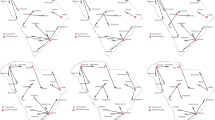Abstract
This paper presents a technique for comparing the results of different assembly line balancing strategies by using Data Envelopment Analysis (DEA). Initially, several heuristics--which can be thought of as assembly line balancing strategies--were used to solve seven line-balancing problems. The resulting line balance solutions provided two pieces of information that were of particular interest: the number of workers needed and the amount of equipment needed. These two items were considered inputs for DEA. The different line balance solutions were then used as layouts for simulated production runs. From the simulation experiments, several output performance measures were obtained which were of particular interest and were used as outputs for DEA. The analysis shows that DEA is effective in suggesting which line balancing heuristics are most promising.
Similar content being viewed by others
References
Allen, R., A. Athanassopoulos, R. G. Dyson, and E. Thanasoulis. (1997). “Weights Restrictions and Value Judgements in Data Envelopment Analysis: Evolution, Development and Future Directions.” Annals of Operations Research 73, 13–34.
Arcus, A. L. (1966). “COMSOAL: A Computer Method of Sequencing Operations for Assembly Lines.” International Journal of Production Research 4, 259–277.
Banker, R. D., A. Charnes, and W. W. Cooper. (1984). “Some Models for Estimating Technical and Scale Inefficiencies in Data Envelopment Analysis.” Management Science 30, 1078–1092.
Baybars, I. (1986). “A Survey of Exact Algorithms for the Simple Assembly Line Balancing Problem.” Management Science 32, 909–932.
Boussafiane, R. G., R. G. Dyson, and E. Thanassoulis. (1991). “Applied Data Envelopment Analysis.” European Journal of Operational Research 52, 1–15.
Buxey, G. M. (1974). “Assembly Line Balancing with Multiple Stations.” Management Science 20, 1010–1021.
Charnes, A., W. W. Cooper, and E. Rhodes. (1978). “Measuring the Efficiency of Decision Making Units.” European Journal of Operational Research 2, 429–444.
Charnes, A., W. W. Cooper, A. Y. Lewin, and L. M. Seiford. (1994). Data Envelopment Analysis: Theory, Methodology and Applications. Boston, MA: Kluwer Academic Publishers.
Ding, F., and L. Cheng. (1993). “An Effective Mixed-Model Assembly Line Sequencing Heuristic for Just-in-Time Production Systems.” Journal of Operations Management 11, 45–50.
Doyle, J. R., and R. H. Green. (1991). “Comparing Products Using Data Envelopment Analysis.” OMEGA: International Journal of Management Science 19, 631–638.
Gaither, N. (1996). Production and Operations Management, Seventh Edition. Belmont, California: Wadsworth Publishing Co., pp. 297–299.
Gonzalez-Lima, M., R. A. Tapia, and R. M. Thrall. (1996). “On the Construction of Strong Complementary Slackness Solutions for DEA Linear Programming Problems Using a Primal-Dual Interior Point Method.” Annals of Operations Research 66, 139–162.
Helgeson, W. B., and D. P. Birnie. (1961). “Assembly Line Balancing Using the Ranked Positional Weight Technique.” The Journal of Industrial Engineering 12, 394–398.
Mariotti, J. (1970). “Four Approaches to Manual Assembly Line Balancing.” Industrial Engineering 21, 35–40.
McMullen, P. R. (1995). “A Simulation Approach to Solving the Type I Assembly Line Balancing Problem for Mixed-Models with Stochastic Task Durations.” Doctoral Dissertation: University of Oregon.
McMullen, P. R., and G. V. Frazier. (1997). “A Heuristic for Solving the Mixed-Model Line Balancing Problem With Stochastic Task Durations and Parallel Stations.” International Journal of Production Economics 51(3), 177–190.
McMullen, P. R., and G. V. Frazier. (1998). “Using Simulated Annealing To Solve A Multiobjective Assembly Line Balancing Problem With Parallel Work Stations.” International Journal of Production Research 31(10), 2717–2741.
Moodie, C. L., and H. H. Young. (1965). “A Heuristic Method of Assembly Line Balancing for Assumptions of Constant of or Variable Work Element Times.” The Journal of Industrial Engineering 16, 23–29.
Pinto, P. A. (1975). “Assembly Line Balancing with Paralleling.” Doctoral Dissertation: University of North Carolina at Chapel Hill.
Pinto, P. A., D. A. Dannenbring, and B. M. Khumawala. (1975). “A Branch and Bound Algorithm for Assembly Line Balancing with Paralleling.” International Journal of Production Research 13, 183–196.
Pinto, P. A., D. A. Dannenbring, and B. M. Khumawala. (1981). “Branch and Bound and Heuristic Procedures for Assembly Line Balancing with Paralleling of Stations.” International Journal of Production Research 19, 565–576.
Talbot, F. B., J. H. Patterson, and W.V. Gehrlein. (1986). “AComparison of Heuristic Line Balancing Techniques.” Management Science 32, 430–454.
Thompson, R. G., P. S. Dharmapala, J. Diaz, M. D. Gonzalez-Lima, and R. M. Thrall. (1996). “DEA Multiplier Analytic Center Sensitivity with an Illustrative Application to Independent Oil Companies.” Annals of Operations Research 66, 163-177.
Thompson, R. G., P. S. Dharmapala, and Robert M. Thrall. (1994). “Sensitivity Analysis of Efficiency Measures with Applications Farming and Illinois Coal Mining.” In Data Envelopment Analysis: Theory, Methodology and Applications. Boston: Kluwer Academic Publishers, pp. 393–422.
Thompson, R. G., L. N. Langemeier, C. Lee, E. Lee, and R. M. Thrall. (1990). “The Role of Multipler Bounds in Efficiency Analysis with Application to Kansas Farming.” Journal of Econometrics 46, 93–108.
Thrall, Robert M. (1996). “Duality, Classification and Slacks in DEA.” Annals of Operations Research 66, 109–137.
Tonge, F. M. (1961). “A Heuristic Program of Assembly Line Balancing.” Management Science 7, 21–42.
Tonge, F. M. (1965). “Assembly Line Balancing Using Probabilistic Combinations of Heuristics.” Management Science 11, 727–735.
Wong, Y.-H. B., and J. E. Beasley. (1990). “Restricting Weight Flexibility in Data Envelopment Analysis.” Journal of the Operational Research Society 9, 829–835.
Author information
Authors and Affiliations
Rights and permissions
About this article
Cite this article
McMullen, P.R., Frazier, G.V. Using Simulation and Data Envelopment Analysis to Compare Assembly Line Balancing Solutions. Journal of Productivity Analysis 11, 149–168 (1999). https://doi.org/10.1023/A:1007732016717
Issue Date:
DOI: https://doi.org/10.1023/A:1007732016717




